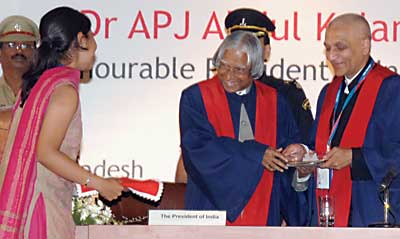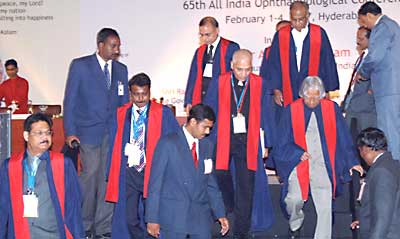Newest president of ophthalmic society maps out his goals
 Taraprasad Das |
In February, Taraprasad Das, FRCS, assumed the presidency of the All India Ophthalmological Society after serving as the vice president from 2005 to 2006.
In an address, titled “The New Middle,” given to attendees of the Society’s 65th conference, Dr. Das described what he said he hopes will be the direction of Indian ophthalmology through a current “knowledge revolution.”
“This new knowledge is no more confined to new medicines and devices. This new knowledge is no more confined to understanding new pathology behind the diseases. This new knowledge is no more confined to a few individuals and institutions. In the new knowledge society, everyone has equitable share,” he said.
In a telephone interview with Ocular Surgery News, Dr. Das described his concept of the “new middle” and discussed his goals as president of the society.
The ‘new middle’
Rapid advances in ophthalmology, combined with the explosion of the Internet, have meant greater accessibility to research protocols and data, leaving no room for anybody to be left out of the research process, Dr. Das said.
“Most people stay in the extremes,” he said. “And the middle portion of the people, they don’t have much say, but they are the full strength, so I am hoping that we can shift the lower end to the middle side so that we have more opportunities.”
In India, there are three primary ophthalmic research facilities, and according to Dr. Das, ophthalmologists tend to say they believe that only these larger institutions are capable of research work.
“With this kind of connectivity all over the world, I do not see a reason why people should stay behind, and in India, somehow there is a feeling that only the big institutions can do good clinical work or good patient care,” he said.
“This should not be true anymore, and we have seen examples in the United States where patient care is uniformly good whether in a university or a small-town practice, but the standard is still the same,” Dr. Das said. “In fact, the standard of patient care is much better if you are a single practice rather than a university because you do not have to wait for a long time. They are not involved in any kind of experimental research.”
Advancing research
Dr. Das has opened his 3-year term as the president of the All India Ophthalmological Society by creating the India Ophthalmology Clinical Research site (www.iocr.net) in order to accomplish some of his goals. The Web site is expected to be operational in September, after the society conducts its executive meeting.
The Web site will serve as a virtual meeting point for Indian ophthalmologists to share clinical research protocols and answer important questions necessary to further Indian ophthalmic research, he said.
“Suppose we say that [optical coherence tomography] would be an indicator for all the detection of diabetic macular edema, and the first thing we need to know is what the retinal thickness of the Indian population is and there are 150 machines in the country. If we put in the protocol and had a proper inclusion/exclusion criterion, we can answer this question in a month’s time because at least 75 to 150 machines in India can put their pictures on the net,” he said.
Within the next year, Dr. Das said, he would like to use this system to pursue such endeavors as defining the normal macular thickness and the normal axial length of the Indian eye.
“I hope that in a year’s time we will be able to answer at least 10 or 12 questions for all the societies of ophthalmology,” he said.
According to Dr. Das, there are more than 12,000 ophthalmologists in India, placing it in the position to be a leader in Asian ophthalmology. In order to enhance the country’s role as a regional leader in education and research, it is also important to forge stronger connections with societies around the world, he said.
For example, the American Academy of Ophthalmology has offered membership discounts to Indian ophthalmologists, according to Dr. Das.
“The American Academy of Ophthalmology has agreed that they will induct many members of the society at a reduced cost, to reduce the price to $160 a year vs. $475 or so for regular members, so this will help a lot of Indian doctors become members,” he said.
|
Images: Das T |
Facing the future
Plans to enhance standardization of education and to explore strategies for the growing problem of diabetic retinopathy are also on Dr. Das’ agenda as he looks to develop the society.
“The standard of education is not uniform. There are some universities doing well, some not doing well, and I don’t think society can do anything about it. Only different states, different universities have to help them,” he said. “I am meeting different leaders and bureaucrats and explaining why they should do certain things for the future. Some are kind to me, some are not, but then I don’t give up quickly.”
Improving education standards will give the next generation of Indian ophthalmologists the tools to address the problem of diabetic retinopathy, just as previous generations worked to reduce the amount of cataract blindness in the country, he said.
According to Dr. Das, cataract blindness in India has been reduced from 80% to 47% in some states over the past 30 to 40 years with the help of grants from the World Bank and increased training in IOL implantation.
With the cataract problem being stabilized, Dr. Das said it is now time to look at retinal problems.
“Currently, we have nearly 32 million people who have diabetes mellitus, and nearly 30% of them will have retinopathy, and by 2025, 18 million people will have diabetes … and 30% will have retinopathy. So we find the current retina specialists, which are roughly 200, have to train another 200 at least by the next 2 years to reasonably reduce the backlog,” Dr. Das said.
“We proposed to the government of India and Ministry of Health to come up with a certain amount of money and a road map, and they are closely examining [the problem] and hopefully [soon] they will communicate to us whether they accept all our suggestions or some of our suggestions,” he added.
These things can be accomplished through acknowledging the vast numbers of ophthalmologists in the middle and the potential they hold, Dr. Das said.
“There are only a few people on the right-extreme learning, but the middle can also learn, and this middle can try to bring one from the lower end, from the left corner, bring them to the middle,” he said. “The right corner brings a middle person to the right, and the middle person brings a left person to the middle, and then we have an emerging society.”
For more information:
- Taraprasad Das, FRCS, can be reached at L.V. Prasad Eye Institute, L V Prasad Marg, Banjara Hills, Hyderabad 500 034, Andhra Pradesh, India; +91-40-3061-2345; fax: +91-40-2354-8271; e-mail: tpd@bei-lvpei.org.
- Jared Schultz is an OSN Staff Writer who covers all aspects of ophthalmology. He focuses geographically on Europe and the Asia-Pacific region.


